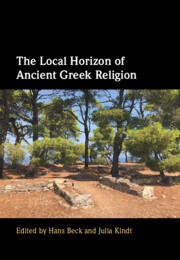Book contents
- The Local Horizon of Ancient Greek Religion
- The Local Horizon of Ancient Greek Religion
- Copyright page
- Contents
- Figures
- Contributors
- Preface
- Abbreviations
- 1 Localism and the Study of Ancient Greek Religion: The Example of the Divine Persona
- 2 Refitting the Local Horizon of Ancient Greek Religion (Including Some Remarks on the Sanctuary of Poseidon on Kalaureia)
- 3 Mycenaean Greek Worship in Minoan Territory
- 4 Hera on Samos: Between the Global and the Local
- 5 Polytheism and the Distribution of Votives in the Corinthia
- 6 Demeter Chthonia at Hermione: Landscapes and Cult
- 7 Local Variation in the Thesmophoria Festival: A Case Study of the Attic and Sicilian Thesmophoria Festivals
- 8 The Lindian Chronicle and Local Identity
- 9 Shifting Identities and Defensive Localism: Conflicts of Religious Narratives in Post-Synoikism Rhodes
- 10 Between Local and Global? Religion in Late-Hellenistic Delos
- 11 Personal or Communal? Social Horizons of Local Greek Religion
- 12 How to Write a Local History of Imperial Greek Cults: Observations from Pausanias
- 13 Panhellenic Sanctuaries: Local and Regional Perspectives
- Epilogue: A Tribute to Potnia of the Labyrinth
- Index
- References
3 - Mycenaean Greek Worship in Minoan Territory
Published online by Cambridge University Press: 06 April 2023
- The Local Horizon of Ancient Greek Religion
- The Local Horizon of Ancient Greek Religion
- Copyright page
- Contents
- Figures
- Contributors
- Preface
- Abbreviations
- 1 Localism and the Study of Ancient Greek Religion: The Example of the Divine Persona
- 2 Refitting the Local Horizon of Ancient Greek Religion (Including Some Remarks on the Sanctuary of Poseidon on Kalaureia)
- 3 Mycenaean Greek Worship in Minoan Territory
- 4 Hera on Samos: Between the Global and the Local
- 5 Polytheism and the Distribution of Votives in the Corinthia
- 6 Demeter Chthonia at Hermione: Landscapes and Cult
- 7 Local Variation in the Thesmophoria Festival: A Case Study of the Attic and Sicilian Thesmophoria Festivals
- 8 The Lindian Chronicle and Local Identity
- 9 Shifting Identities and Defensive Localism: Conflicts of Religious Narratives in Post-Synoikism Rhodes
- 10 Between Local and Global? Religion in Late-Hellenistic Delos
- 11 Personal or Communal? Social Horizons of Local Greek Religion
- 12 How to Write a Local History of Imperial Greek Cults: Observations from Pausanias
- 13 Panhellenic Sanctuaries: Local and Regional Perspectives
- Epilogue: A Tribute to Potnia of the Labyrinth
- Index
- References
Summary
Reference in the Linear B record to deities of the later pantheon, for instance Poseidon, Zeus, and Hera, among others, vividly attests to the Mycenaean pedigree of Greek religion. This chapter suggests that the resonance with local place, so foundational a characteristic of Hellenic belief in later times, also derived from Mycenaean origins. To this end, Susan Lupack decodes the complicated helix of Minoan and Mycenaean religion, illustrating that Mycenaean religion evolved through appropriations from the Minoans. The artefacts retrieved from the tomb of the Griffin Warrior in Pylos showcase the creative Minoan–Mycenaean mix. Tracing the movement of Mycenaean peoples to Crete, the linguistic examination of the famous Room of the Chariot-Tablets from Knossos demonstrates how the first wave of arrivals predominantly practised the religion they had brought with them from their mainland homes. A second assemblage from Knossos from only ca. sixty years later shows that the Mycenaeans now not only made an effort to worship Minoan deities, but also lent a new guise to their gods and goddesses, relating them to, and embedding them in, the land of the Minoans.
- Type
- Chapter
- Information
- The Local Horizon of Ancient Greek Religion , pp. 67 - 104Publisher: Cambridge University PressPrint publication year: 2023
References
- 1
- Cited by



